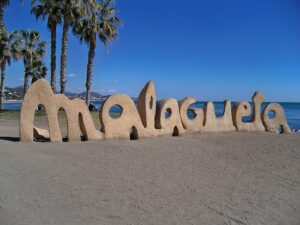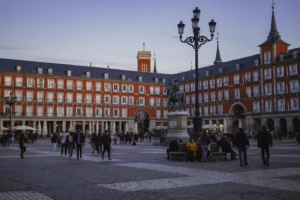Are you among the 15% of foreigners who have bought in Spain, are you planning to do renovation work and you feel overwhelmed by a sense of panic at the idea of not understanding anything? Take a breath, the experts at Terreta Spain have prepared THE essential glossary of real estate renovation in Spain for you. It is not exhaustive and does not go into overly technical aspects, the goal here is to allow you to communicate simply with your workers if they do not speak French, to avoid misunderstandings and misinterpretations.
Let's go.
A
ACABADOS
The finishes, that is to say the last works carried out on a construction site. They include all the elements that give the final appearance to a building or a room (paints, coatings, tiles, decorative details, etc.). In Spain as elsewhere, the choice of finishes greatly influences the budget of the works.
ADHESIVOS
All substances used to glue or bind two surfaces together. The choice of appropriate adhesives depends on the type of material, the intended use (interior/exterior) but also the climatic conditions.
AISLAMIENTO ACÚSTICO
This refers to acoustic insulation, which aims to improve sound comfort inside buildings, whether residential or not. Particular attention should be paid to this insulation if you are investing in a densely populated area or in the city center, near restaurants, bars, and lively places. Spaniards have a reputation for being a bit noisy. Our team won't deny it... But it's this zest for life that we love.
AISLAMIENTO TÉRMICO
Thermal insulation. It is essential in carrying out the work. The goal is to prevent heat transfer between the interior and exterior. There are several insulation techniques, and choosing the right one can reduce the need for heating and air conditioning. In a country like Spain, this is essential to reduce the energy consumption of homes. To delve deeper into this topic, check out our article: "Energy renovation in Spain, the complete guide".
ALBAÑIL
A bricklayer, a construction worker.
ALCANTARILLADO
The sewage system. Your future home must be well connected to the urban network to properly dispose of wastewater.
APAREJADOR
The site manager or technical architect (arquitecto técnico). This is a key professional in the construction sector. Their main responsibilities are:
- The technical direction of the execution of the works
- The supervision of the quality of materials and construction
- The coordination of the various trades
- The control of costs and deadlines
- Guaranteeing compliance with safety standards and regulations
ARQUITECTO
A qualified and accredited architect, responsible for the design and planning of buildings and spaces. They are in charge of:
- The design of plans and technical drawings
- The creation of the overall aesthetic of the building
- He ensures compliance with construction regulations
- He supervises the project in its entirety
- He coordinates with other professionals involved in the project.
Not to be confused with the construction manager (the aparejador) who has a more technical profile.
AYUNTAMIENTO
The town hall. You will mainly hear about the town hall at the beginning of your project, as it is the one that issues work and construction permits.
AZULEJO
In our opinion, the most beautiful word in this real estate renovation lexicon in Spain. It refers to the famous glazed ceramic tiles, particularly those from the Valencia region.
B
BALCÓN
A balcony.
BALDOSA
A tile or slab.
BAÑO
The bathroom.
BARANDILLA
A railing or guardrail.
BOMBA DE CALOR
The heat pump in Spanish. It transfers heat from one medium to another for heating or air conditioning purposes. It consumes very little electrical energy.
Don't have time to manage your renovations? Terreta Spain is your trusted partner for renovations in Spain. Contact us.

C
CALEFACCIÓN
The heating system in Spanish. Let's break it down:
- Calefacción central: central heating
- Calefacción de gas: gas heating
- Calefacción eléctrica: Electric heating
CANALÓN
A gutter, an element of the rainwater drainage system. Generally, it is installed along the roofs. Canalones are essential to protect the foundations and walls of the building against moisture and water damage.
CARPINTERO
A carpenter.
CATASTRO
The land registry (cadastre) is a public record containing information on real estate properties. It is a detailed inventory of all real estate in the country, whether urban, rural, or special-purpose. It includes physical (area, location, boundaries), economic (cadastral value), and legal (owner, real rights) data on each property. It also serves as the basis for calculating certain taxes such as IBI (Impuesto sobre Bienes Inmuebles, equivalent to property tax). Note that the land registry information is publicly accessible, making it an important tool for real estate transactions and urban planning.
CÉDULA DE HABITABILIDAD
This is an administrative document certifying that a dwelling meets the minimum habitability and safety standards required by law. It specifies the living area, the number of rooms, and confirms that the dwelling has basic facilities (water, electricity, sanitation). Its validity period varies by region, generally extending from 10 to 15 years. Without this certificate, it is legally impossible to inhabit or rent the dwelling. To obtain it, the dwelling must be inspected by an approved technician. Upon expiration, the certificate must be renewed, which may require upgrades to the dwelling to meet current standards.
CERTIFICACIÓN DE OBRA
This is a document validated by a technician that describes the quantity and quality of work completed to date on a construction or renovation site. It allows for the official tracking of work progress and is often used as a basis for staggered payments to contractors or builders.
Furthermore, it provides the owner with a guarantee that the work is being carried out according to the agreed terms.
CERTIFICADO DE EFICIENCIA ENERGÉTICA (CEE)
The energy efficiency certificate in Spain. It indicates the energy performance of a building and has been mandatory in Spain since 2013.
CHAPA
The name for sheet metal.
CÓDIGO TÉCNICO DE LA EDIFICACIÓN (CTE)
The Technical Building Code, a set of regulations governing construction in Spain.
COMUNIDAD AUTÓNOMA
Autonomous Community. In Spain, there are 17 administrative regions, each with its own specific legislation. When undertaking renovation work, it is essential to inquire about the effective legislation in the area where you have purchased. To do this, contact the town hall (ayuntamiento).
COMUNIDAD DE PROPIETARIOS
The homeowners' association. They must be informed of the work you are planning and may object to it. For more information, see our guide: "All you need to know about renovation in Spain".
CONTADOR
The water, electricity, or gas meter.
CORNISA
The cornice. A molding that runs horizontally at the top of a wall.
Not to be confused with the zócalo, the baseboard, at the bottom of the wall.
D
DECLARACIÓN RESPONSABLE
A declaration of responsibility for certain minor works that have not been authorized by a building permit. It certifies compliance with current regulations.
DEMOLICIÓN
Demolition.
DESVÁN
Attic.
DORMITORIO
Bedroom.
Do you want to delegate your renovation work in Spain? Contact our experts based locally, they will take care of your work for you.
E
EDIFICABILIDAD
The buildability of a given plot of land.
ELETRICISTA
Electrician.
EMPOTRAMIENTO
Embedding in a wall or structure. For example, a cabinet, sockets or household appliances.
ENCOFRADO
Formwork is a temporary structure used to contain concrete when it is poured. The formwork shapes the concrete until it hardens.
ENERGÍA RENOVABLE
Renewable energy in Spanish. Spain is one of the European leaders in renewable energies, particularly in solar and wind power.
- Solar energy (energía solar)
- Wind energy (energía eólica)
- Hydraulic energy (energía hidráulica)
- Biomass (biomasa)
- Geothermal energy (energía geotérmica)
ESTUDIO DE IMPACTO AMBIENTAL
The environmental impact assessment. It is sometimes required for a Licencia de Obra Mayor (see below).
F
FACHADA
Facade.
FALSO TECHO
False ceiling.
FINCA
This term has two distinct meanings: it refers to both a rural property and a building in Spain.
FERRALLISTA
A metalworker.
FORJADO
The technical term that designates the floor structure. It supports the weight of occupants and furniture and transfers these loads to the load-bearing walls or beams. The forjado is a crucial element in the structure of a building.
FONTANERO
A plumber.
FOSA SÉPTICA
Septic tank.
G
GOTELÉ
The textured paint finish. It is commonly found in Spanish apartments that are often sold "as is."
GRIETAS
Cracks.
Do you have a renovation project in Spain? Contact our experts, they will take care of your work for you.
H
HABITACIÓN
This is a double meaning term. It can refer to a bedroom or a room.
HORMIGÓN
Concrete.
HUELLA
The tread, i.e., the horizontal part of a step on which the foot is placed.
I
ICIO – IMPUESTO DE CONSTRUCCIONES
The Tax on Constructions, Installations and Works. A municipal tax applied to construction, renovation, or demolition work. The rate varies depending on the municipality (generally between 2% and 4% of the cost of the works). This tax must be taken into account in the overall budget of a construction or renovation project.
ÍNDICE DE EDIFICABILIDAD MÁXIMA
The coefficient that defines the maximum buildable area on a plot of land.
INSPECCIÓN TÉCNICA DE EDIFICIOS (ITE)
Technical inspection of buildings, i.e., the mandatory inspection of the general condition of old buildings.
IVA (IMPUESTO SOBRE EL VALOR AÑADIDO)
This is the VAT applied to almost all goods and services. In the Spanish construction sector, it amounts to 10%.
J
JÁCENA
Also called viga maestra. This is the master beam, the one that supports the overall weight of the framework.

L
LANA DE ROCA
Rock wool, an insulating material made from volcanic rock.
LADRILLO
Brick.
LICENCIA DE OBRA
This is the mandatory municipal authorization issued by the town hall (ayuntamiento) to carry out construction work, modify an existing building, or carry out major renovations. There are two types:
- The Licencia de obra mayor: major works, construction
- The Licencia de obra menor: minor works, light renovations
To obtain them, you need the visado and pay municipal taxes. The time to obtain them varies depending on the municipality, and the period of validity of the license is limited. Also note that it must be displayed during the works.
Carrying out work without a license is a serious urban planning violation.
LICENCIA DE PRIMERA OCUPACIÓN
An official document issued by the municipality after completion of construction. It certifies that the building complies with the approved plans and with safety and habitability standards. This permit is required to legally occupy a new or renovated building.
LLAVE EN MANO
The equivalent of "turnkey," an expression that describes a renovation project carried out from start to finish. To delve deeper into this topic, discover our article: "Why opt for a turnkey renovation company in Spain?" (link to be added upon publication)
LOE (LA LEY DE ORDENACIÓN DE LA EDIFICACIÓN)
This is the law governing urban planning in Spain since 1999. Here are the key points to remember:
- It establishes the legal framework that regulates the building construction process and determines the obligations and responsibilities of the various stakeholders involved.
- It defines the technical and administrative requirements for buildings.
- It ensures quality and safety standards in the real estate sector.
LUZ NATURAL
Natural light.
Don't have the time or desire to manage your renovation work in Spain? Contact us, it's our profession.
M
MADERA
Wood.
MAMPOSTERÍA
Rubble masonry is a technique that uses rough, unhewn stones. They are assembled without a precise order and bound by mortar. It is common in Spain, especially in rural or mountainous areas.
MÁRMOL
Marble.
MEDIANERA
A party wall. In urban renovation projects, the management of party walls can be complex, often requiring agreements between neighbors.
MURO DE CARGA
A load-bearing wall.
N
NORMATIVA URBANÍSTICA
Urban planning regulations specific to each autonomous community.
O
OBRA
General works carried out on a building.
- Obra menor: minor works that do not require many permits
- Obra mayor: major works requiring more permits
OCT (ORGANISMO DE CONTROL TÉCNICO)
Technical control organization. It is an independent entity responsible for controlling the technical quality of construction work. Its role is crucial for obtaining ten-year insurance. The OCT verifies that the construction complies with current standards and regulations.
P
PARCELA
A plot, i.e., a delimited portion intended for construction.
PARED
Wall.
PARED MAESTRA
Load-bearing wall supporting a significant portion of the building's weight.
PAVIMENTO
An artificial covering constructed to ensure a solid and flat surface.
PERSIANA
A blind or roller shutter.
PGOU (PLAN GENERAL DE ORGANISATION URBANA)
The Plan General de Ordenación Urbana is a fundamental urban planning document in Spain, which governs the urban development of a municipality. It defines the local urban planning rules necessary to obtain building permits and regulates land use. Each PGOU is public and can be consulted at the urban planning departments of the municipality concerned.
PINTOR
A professional painter.
PLACA SOLAR
A solar panel capturing solar energy to produce electricity or heat.
PLANO
An architectural plan.
PRESUPUESTO
An itemized estimate detailing the anticipated costs for a given project.
PROMOTOR
The project owner, i.e., the individual or entity commissioning and financing the construction or renovation work. They are the primary responsible party for the project and make the final decisions. Their responsibilities include obtaining the necessary permits, financing the project, and providing overall supervision.
PROYECTO DE REFORMA
Project defining all the technical aspects required for the planned work.
PROYECTO TÉCNICO
Technical document required to obtain a Licencia de Obra Mayor.
PUENTE TÉRMICO
Thermal bridge, designating an area where there is a weakness in the building's thermal insulation.

R
RECEPCIÓN DE OBRA
Formal acceptance whereby the builder officially hands over their work to the project owner after completion.
REFORMA INTEGRAL
Complete renovation affecting all aspects of the property.
REHABILITACIÓN
Rehabilitation aimed at restoring an old building.
RODAPIÉ
Baseboard used to protect the bottom of walls against impacts, humidity, etc.
Are you planning to renovate a property in Spain? Terreta Spain specializes in renovation in Spain. Contact us.
S
SALÓN
A living room.
SANEAR
To rehabilitate a space to make it healthy and habitable.
SEGURO DECENAL
Decennial Insurance. Mandatory insurance in Spain for new constructions and certain major renovations. It covers structural damage to the building for 10 years after completion of the work. This insurance protects owners against major construction defects.
SOLAR
Land intended for construction.
SNU (SUELO NO URBANIZABLE)
This type of land is protected and cannot be transformed into a buildable area.
SU (SUELO URBANO)
This is land located in an urbanized area.
SUELO
The ground, the floor.
SUELO HIDRÁULICO
Traditional Spanish tiling.
Do not be mistaken, this type of tiling is different from azulejos. Hydraulic tiling is made from pressed colored cement, while azulejos are made from glazed ceramic.
SUELO URBANIZABLE
Buildable land, that is to say, land intended to be developed according to regulations and urban plans. An important concept if you are looking to acquire land or expand an existing property.
SUMIDERO
A drain that allows the efficient evacuation of wastewater.
SUPERFICIE COMPUTABLE
This is the area of land or a building that is taken into account in urban planning calculations according to the regulations in force in Spain. The superficie computable serves as a reference for the application of urban planning standards and the determination of building rights. It is used by urban planning services for calculating the land occupation coefficient, establishing the maximum authorized construction density, determining the buildable height limits, and calculating the mandatory green space quotas.
Do not confuse with the total area, or the cadastral area.
SUPERFICIE BRUTA
The total area, it includes all structures.
SUPERFICIE NETA
The actual surface area, excluding structural elements.
SUPERFICIE ÚTIL / CONSTRUIDA:
- Superficie útil (usable area): this is the area that can actually be used inside a dwelling, excluding walls, partitions, and technical spaces.
- Superficie construida (built area): this is the total area of the dwelling, including walls and common areas. It is generally 10-15% larger than the usable area.
This distinction is essential for understanding the true value of a property.
T
TABIQUE
A word you will often encounter if you embark on construction work in Spain. It is a non-load-bearing partition.
TECHO
The ceiling.
TEJA
A tile.
TEJADO
The roof.
TERRAZA
The first word that foreigners who want to become property owners in Spain learn: the terrace. The one they have always dreamed of.
TERRAZA A LA CATALANA
This is a traditional type of roof terrace characteristic of Mediterranean architecture, particularly developed in Catalonia. It has been used since the Middle Ages and is known for its bioclimatic qualities. This flat roof consists of several specific technical layers to ensure maximum natural thermal insulation, passive ventilation and high durability.
TRASTERO
A storage room. It is very common to find apartments with trastero in Spain.
TUBERÍAS
All the conduits transporting fluids such as water or gas.
V
VARILLA
A steel rod or bar used in construction, mainly for reinforcing (assembling) reinforced concrete, as metal reinforcement, or as structural reinforcement.
VENTANA
A window.
VENTILACIÓN
The ventilation system.
VISADO DE OBRA
This is the official endorsement that guarantees the mandatory validation of a construction project by the Spanish College of Architects or Engineers. It certifies that the technical documents are compliant, that the professional in charge of the work is authorized, and that the construction standards are respected. The visado de obras implies professional responsibility, protects the client, and, above all, allows for obtaining the building permit.
It is required for new constructions, major renovations, and structural modifications to an existing property. Its cost varies depending on the project.
It is different from the municipal building permit (la licencia de obra).
VIGAS
Horizontal beams supporting the weight of upper structures.
VPO (VIVIENDAS PROTEGIDAS)
A vivienda protegida in Spain, also called vivienda de protección oficial (VPO), is a type of housing subsidized by the government. The goal is to provide affordable housing to people with average or low incomes.
- Their price is regulated: they are sold or rented at prices below those of the free market.
- Buyers or tenants generally have to meet certain criteria, such as income ceilings.
- There are often restrictions on the resale or rental of these properties for a certain period (10 to 30 years).
Y
YESO
Plaster.
Z
ZANCA
The zanca is the stringer of a staircase, i.e., the element that supports the steps. Its main load-bearing structure.
ZÓCALO
A decorative and protective baseboard in relief. It runs along the bottom of the walls, protects against shocks and humidity, and ensures the floor-wall transition.
Not to be confused with: cornice (at the top), the cornisa in Spanish.
To go further, discover our practical guide to real estate renovation. (to be linked once published).
FAQ: Real Estate Renovation Lexicon in Spain
What are the essential technical terms for understanding building permits in Spain?
Essential terms include Licencia de Obra Menor (permit for minor works), Licencia de Obra Mayor (permit for major works), Proyecto Técnico (technical project), Visado (project approval by the association of architects), and Declaración Responsable (declaration of responsibility for certain minor works).
How do local authorities manage building permits in Spain?
Permits are generally managed by the Ayuntamiento (city council) of each municipality. The process often involves submitting a file including plans, the technical project, and sometimes an environmental impact study. Processing times vary depending on the municipality and the complexity of the project.
What diagnostics are required before starting a renovation in Spain?
Common diagnostics include the Certificado de Eficiencia Energética (energy efficiency certificate), the Inspección Técnica de Edificios (ITE, equivalent to the global technical inspection), and sometimes a study of the building's structure, especially for older properties or major works.
What are the criteria for obtaining a Licencia de Obra Mayor in Spain?
The main criteria are:
– Submission of a complete technical project signed by an architect
– Compliance with the local Plan General de Ordenación Urbana (PGOU) (General Urban Development Plan)
– Compliance with safety and accessibility standards
– Payment of corresponding municipal taxes
– In some cases, an environmental impact study may be required
Sources: Segurox , Wikipedia, Diccionario de la lengua española







